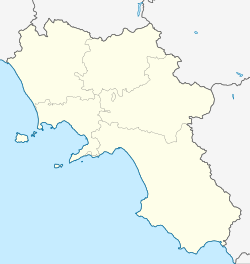
Back Capri Afrikaans قبرة (جزيرة) Arabic كابرى ARZ Kapri (ada) Azerbaijani Капри Bashkir Капры (востраў) Byelorussian Капри (остров) Bulgarian ক্যাপ্রি Bengali/Bangla Enez Capri Breton Capri Catalan
 View from Massa Lubrense, Campania | |
| Geography | |
|---|---|
| Location | Tyrrhenian Sea |
| Coordinates | 40°33′00″N 14°14′00″E / 40.55000°N 14.23333°E |
| Area | 10.4 km2 (4.0 sq mi) |
| Highest elevation | 589 m (1932 ft) |
| Highest point | Monte Solaro |
| Administration | |
Italy | |
| Region | Campania |
| Metropolitan City | Naples |
| Largest settlement | Capri (pop. 7,058 (Capri comune, 2022)) |
| Demographics | |
| Population | 12,903 (Capri + Anacapri comuni) (1 Jan 2022 [1]) |
| Pop. density | 1,170/km2 (3030/sq mi) |
Capri (/ˈkæpri/ KAP-ree, US also /kəˈpriː, ˈkɑːpri/ kə-PREE, KAH-pree; Italian: [ˈkaːpri]) is an island located in the Tyrrhenian Sea off the Sorrento Peninsula, on the south side of the Gulf of Naples in the Campania region of Italy. A popular resort destination since the time of the Roman Republic, its natural beauty, historic sites, and upscale tourism have made it famous worldwide.
The island is characterized by its rugged limestone landscape, sea stacks (Faraglioni), coastal grottoes including the renowned Blue Grotto, and high cliffs overlooking the sea. Notable features include the harbours of Marina Grande and Marina Piccola, the panoramic Belvedere of Tragara, the ruins of Roman imperial villas such as Villa Jovis, and the towns of Capri and Anacapri, the latter situated higher up the slopes of Monte Solaro, the island's highest point.
Administratively, Capri is part of the Metropolitan City of Naples within the Campania region. The island is divided into two municipalities (comuni): Capri and Anacapri.
- ^ "Bilancio demografico mensile". ISTAT. 1 January 2022. Retrieved 29 April 2025.
